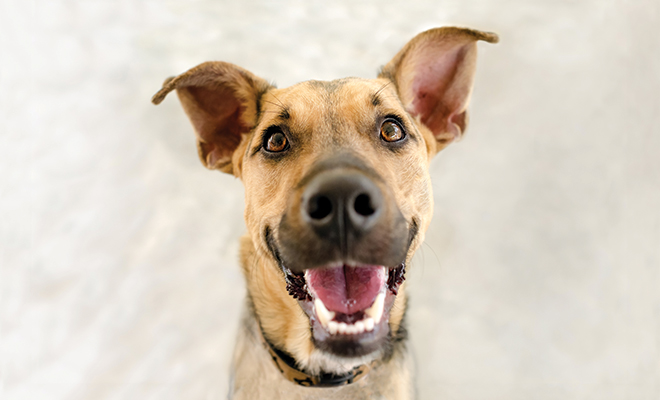
A Dog’s Dental Health = Good Quality of Life
Veterinarian and canine dental specialist Dr. Donnell Hansen often tells the story of Patches, a stray who reacted to his rescuer’s attempts at affection by growling and biting.
When Patches showed up at the Blue Pearl Pet Hospital, Dr. Hansen discovered that the dog had severe periodontal disease. “We extracted two abscessed teeth. His teeth hurt so much,” she said. “But after we treated him, his owner brought him back and he was cuddling in his mom’s arms,” she said. “He was relaxed and playful. He really was friendly but he’d been in so much pain. When you have dental disease, the quality of your life is compromised.”
Often, owners don’t know that their dogs have dental problems, since dogs tend to hide their pain. While most owners are careful to attend to the health needs of their canine companions, many don’t consider their dog’s dental health the way they do other health concerns. But many veterinarians say that tooth care should be on the top of the healthcare list.
Some breeds are more likely to have tooth problems. Small dogs are more prone to tooth loss than larger dogs. Dogs have 42 teeth, and that includes small dogs. “You would think that as the dogs shrink in size, so would their teeth, and they do, but not much. Little dogs have huge teeth for their little mouths, which can lead to problems,” said Hansen. “Some dogs have problems with the shape of their heads. Bully breeds are more prone to painful malocclusions, problems with the way teeth meet when the jaws close. Large breeds are more likely to fracture their teeth.”
While some dogs never have tooth or gum problems due to their genetics, diet or chewing behaviors, others can have chronic problems. Most dog dental problems can be avoided if their owners spend a few minutes a day to clean their dog’s teeth, said Hansen. “Don’t laugh, but doggie breath is not normal. It’s a first symptom,” she said. Bad breath can be followed by bleeding and loss of appetite. Food can drop from the dog’s mouth because of pain. The roots can become infected, leading to tooth loss. Bad teeth can also lead to kidney, liver and heart damage.
To maintain a healthy mouth, dog owners need to brush their dog’s teeth, said Dr. Stephanie Goldschmidt, professor of veterinary medicine at the University of Minnesota. She recommends that after professional cleaning, dog parents slowly introduce dogs to tooth brushing. For the first week, she said, raise your dog’s lips and touch their teeth, followed by treats and praise. During the second week, touch your dog’s tooth with a soft, nylon-bristled pet or infant toothbrush. During the third week, begin brushing the outside surface of the teeth while the dog’s mouth is closed. “It may help to do a small area of the mouth and then break for a treat,” she said. Once the dog accepts the brushing, try to do it every day, placing the brush at a 45-degree angle to the gum line, using a circular motion. “You don’t need to brush inside of the teeth, since the tongue will keep this area clean.”
It’s important to start with a clean mouth; brushing alone won’t remove calculus, the mineralized plaque that appears brown on the teeth, Dr. Goldschmidt said. “Under no circumstances should a dog be subjected to a complete vet teeth cleaning without anesthesia. This can be a very scary experience for dogs. They will jerk or move their heads during an awake cleaning, resulting in cuts to the gums.”
Veterinarians warn against using human toothpaste, which contains ingredients that can harm dogs. There are dog-specific toothpastes on the market, but Dr. Goldschmidt notes warm water or chicken broth will work. “The most important part of brushing is the mechanical action of the brush to remove plaque.”
Dogs can also be encouraged to chew toys and to eat treats created specially to help clean plaque from teeth. Hard toys aren’t recommended as dogs, especially aggressive chewers, can fracture their teeth. The Veterinary Oral Health Council lists tested and approved products that include soft rawhide chews and greenies. Their list recommends only products they have tested. “Kongs are softer toys and you can hide foods inside them. Rope toys are good and can be soaked in chicken broth. But, as always, supervise your dog with a toy,” Dr. Hansen said.
In addition to tooth and gum diseases, dogs can also develop fast-growing mouth tumors. Watch for excessive drooling, difficulty chewing, bad breath, loose teeth and weight loss, although sometimes there are no symptoms. “Some breeds, such as golden retrievers, are predisposed to oral tumors,” Dr. Hansen noted. It’s important for dog owners to periodically check inside their dog’s mouth just in case. ■
Sources: pets.webmd.com, vohc.org and whole-dog-journal.com.







